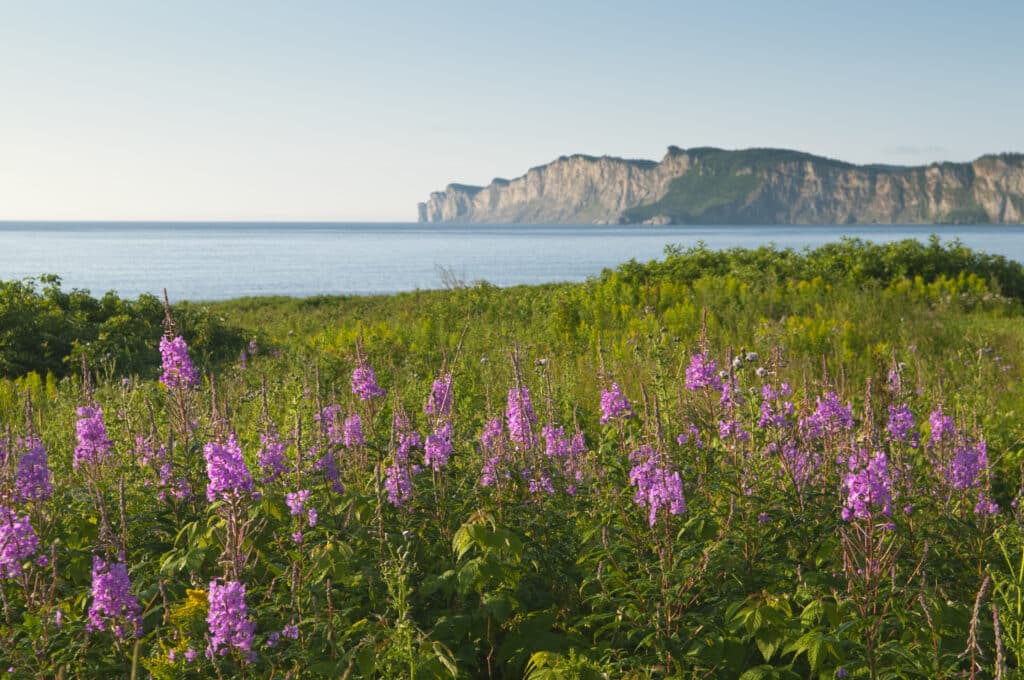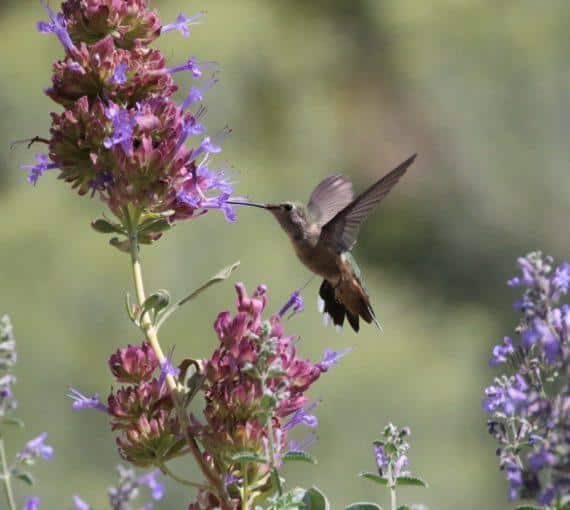
Fireweed, a wildflower native to Quebec, lines the waterfront of Gaspe Peninsula.
What may seem like a small contribution — a tiny flowerpot or garden patch of native wildflowers — can provide valuable habitat for Quebec pollinators such as hummingbirds, bees and butterflies.
Native wildflowers are adapted to local climate and soils and require less care and watering once established. They provide sugar-filled nectar and protein-rich pollen for beneficial insects such as local butterflies and wild bees. Always try to find local sources for native plants.
Pollinators of Quebec
Quebec is teeming with pollinators. Osmia tersula, a stingless, solitary native bee that nests in boreal forests, could even be the answer to northern Quebec’s fruit and vegetable importation problems because it can survive in greenhouses. Native bees in greenhouses don’t disrupt local ecosystems.
It’s important to understand the impact pollinators have on nature and the economy. Pollinators maintain biodiversity, support plant reproduction and provide many other ecological services.
All pollinators have a vital, often-overlooked role in our economy. By pollinating many crops humans consume and trade, they’re essential to our food security. Scientists estimate that approximately 75 per cent of the world’s flowering plants and 35 per cent of global food crops depend on animal pollinators to produce. In Ontario, pollinators are vital to 32 economically important crops.
To thrive, pollinators need food and shelter. Help them support you — create a pollinator paradise!
How to get started
Find your ecoregion’s native plants and wildflowers.
Planting native plants and wildflowers supports local pollinators that have evolved to depend on those species for food and habitat.
Source native seeds and plants
Seeds can be organic (grown without synthetic fertilizers and pesticides), non-GMO (cultivated through pollination, not in a lab), open-pollinated (by nature e.g., insects, birds, wind, humans), heirloom (with an open-pollinated heritage) and rare. Look for native plants in local nurseries!
Start a pollinator paradise
A manicured lawn is not pollinator-friendly. But a yard, community garden, patio or window box filled with native plants can be a pollinator paradise.
Why choose native plants and wildflowers?
Native plants and wildflowers have evolved in this climate for generations. By creating a naturescape (native plant garden), you’ll help solve pollinator habitat loss. By avoiding expensive fertilizers and toxic pesticides, you’ll save time and money.
Native wildflowers and plants of Quebec
Quebec is Canada’s largest province, so it’s not surprising it’s filled with many beautiful and unique native wildflowers and plants, including:
- Common milkweed
- Hairy beardtongue
- Heart-leaved aster
- Seaside goldenrod
- Pearly everlasting
… and more!
Want to take another step?
Determine which ecoregion you live in and plant native wildflowers and plants specific to that area. Each ecoregion has unique ecological characteristics and, though many plants and wildflowers are native to multiple ecoregions, you may discover one that only grows where you live!
What’s an ecozone or ecoregion?
Canada has 20 ecozones (15 terrestrial and five marine) based on differences in climate, geology, landforms, vegetation and wildlife. They help identify and manage unique ecological regions.
Within each ecozone are ecoregions defined by a characteristic range and pattern in climatic variables.
Quebec’s seven ecozones are Arctic Cordillera, Southern Arctic, Taiga Shield, Atlantic Maritime, Mixedwood Plains and Boreal Shield. Within these are 20 ecoregions.
We have planting guides for Quebec’s most populated ecoregions. For more resources and plant lists visit Pollinator Partnership Canada.
POLLINATOR PLANTING GUIDES FOR QUEBEC
The Butterflyway Project
The Butterflyway Project is a volunteer-led movement that is growing habitat for bees and butterflies in neighbourhoods throughout Canada.



